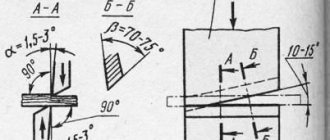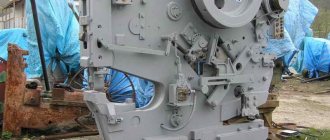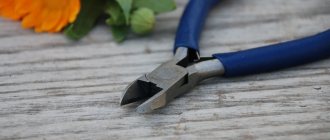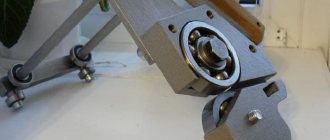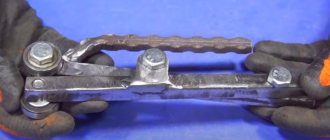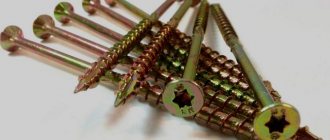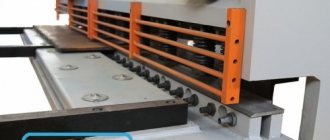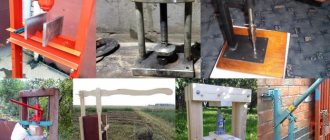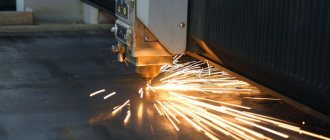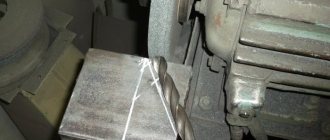Hands from the right place | 03/24/2016
Each of us came across this simple tool in labor lessons; everyone remembers how difficult it was to cut pieces of sheet metal with heavy, indestructible Soviet metal scissors. But time does not stand still; when we go to the nearest construction tools supermarket, we will see a huge number of varieties of those same simple metal scissors. Lever, curly, right and left, with or without insulating handles, there are even professional hand-held metal snips that cost the same as a decent set of tools. And so as not to get confused, let's figure it all out!
What are metal scissors
From the name it becomes clear for what purposes the devices in question are intended. Like regular scissors, metal cutting devices are designed only for working with sheet materials. It is impossible to cut pipes, angles and profiles with metal cutting devices, since they are not designed for this, and simply will not cope with this task.
Structurally, hand-held metal scissors consist of handles and cutting knives. The mobility of the knives is ensured by the mounting bracket. The sharpening angle of cutting knives is 60-75 degrees. This sharpening angle ensures high performance with minimal effort. The large sharpening angle means that the tool can be used for cutting hard metal sheets. The knives in relation to the handle are located at an angle of 7 to 12 degrees.
The knives of the tools in question are made of alloy (chrome-vanadium) or tool steel, which has a positive effect not only on the quality of the cut, but also on the service life. When the blades on knives become dull, they can be sharpened. The tool handles are covered with plastic, rubber or silicone material for ease of work.
This is interesting!
Many people use hand-held metal shears to cut thin sheet metal, such as galvanized sheets or corrugated sheets, and do not know that there are different types of such tools. Depending on the task at hand, it is necessary to select the appropriate type of tool.
The best hydraulic shears
At construction sites and in auto repair shops you can often find hydraulic shears. They are used for cutting through reinforcement or bolts. High force on the cutting edges is supplied thanks to a hydraulic drive. The following tool has proven itself well among domestic users.
KVT BRG-12
Rating: 4.9
A safe and effective tool for cutting reinforcement, rods or bolts are the hydraulic shears KVT BRG-12. The Russian development allows you to bite pieces with a diameter of 4 to 12 mm. The hydraulic drive creates a powerful force (5000 kg), and the sharp blades instantly dig into the metal structure. Experts note the high hardness of the cutting jaws (52...54 HRC); they are easily removed for sharpening or replacement. The working head is C-shaped, to return the closed blades to their original position, a pressure relief valve is installed. There is a plastic case for storage and transportation. The weight of the tool is 2.3 kg.
Owners of a hydraulic bolt cutter are satisfied with its durability and safety, affordable price and simplicity of design. They call the narrow scope of application a disadvantage.
Advantages
- strength;
- safety;
- ease of operation;
- practical case.
Flaws
- narrow specialization.
Types of tools
Before you buy hand scissors for cutting thin sheet material, you need to understand their types. To carry out the relevant work on processing sheet steel, you need to take the appropriate tool, which will allow you to achieve the necessary results. What are the devices in question or their types, we will find out further.
- A straight cutting tool is the simplest type of device, which is designed for cutting large circles and straight cutting of material
- Mechanical with curved blades - used for cutting holes, as well as for obtaining cuts of different shapes
- Finger blades with thin blades - used to produce cuts of various shapes. The blades on finger scissors have different positions relative to each other. It follows that tools are divided into left and right, and depending on the task at hand, it is necessary to use the appropriate type of device
- Chair saws - used for cutting thick sheet steel. They cope with steel thicknesses up to 2-3 mm. When cutting thick sheet steel, effort must be made, so the design of the devices has a special bend. This bend is necessary in order to hook the tool to the workbench, thereby ensuring that the upper handle is pressed with high force, increasing the cutting force
- Power - another type of device for cutting sheet metal with a thickness of 2.5 mm. Power mechanical scissors consist of two levers, which are fixed using a hinged bracket. Power tool models come with replaceable discs and blades that can be used to cut metal rods up to 8 mm thick
- Lever scissors are professional models of scissors that are attached to a workbench. The design of such devices is such that one blade is movable and the other is fixed. The movable blade is driven by a handle on the tool. They are used for cutting aluminum, steel, copper, brass, etc. The maximum thickness of steel reaches 4 mm, and brass, copper and aluminum up to 8 mm
All types of scissors are divided into professional and amateur. They differ not only in price, but also in quality. Professional models are made from high-quality materials, so they are intended for constant use. They have a long service life and are 2 times cheaper than amateur ones. Amateur ones are intended for infrequent use, since low-grade types of steel are used for their manufacture.
The best die cutting models
This is the tool that allows you to make not a thin, but a wide cut. A passage of 1 to 3 mm is formed. There is also equipment for chips and their removal. These models are used to make grooves and cutouts in any metal when installing slopes and ebbs. But how can you choose, given the average price, which company is better? For this purpose, a rating of quality devices is presented.
Knipex KN-9055280
Nowadays, a high-quality battery model is one that is produced in Germany. The company equips the device with double blades that cut metal up to 1.2 mm thick. You can cut a groove in plastic even if the thickness of the workpiece is 2 mm. The scissors are made of steel alloy and are not subject to corrosion. There is also a bracket-style chipbreaker that will allow you to process edges without problems. The grip is 2.7 mm. Now many people may like these scissors, thanks to their excellent quality and long service life as described. That is why they are included in this rating. The material is cut through with just a single press, which reduces the number of different procedures. With these scissors you can work quickly and deftly.
Knipex KN-9055280
Advantages:
- Good producer;
- The handle consists of several devices;
- Convenient security add-ons.
Flaws:
- Too expensive device;
- You need to train on workpieces to learn how to work with this device;
- Short duration.
Manual models of metal scissors and their manufacture
The manufacturing process of hand scissors involves the use of two options:
- Forging
- Casting
Models differ in price. Forged devices are much more expensive than cast ones, but they are much more reliable and durable. To make the blade durable, it is subjected to additional heat treatment. Hardening the cutting part prevents dulling of the cutting part, so it is extremely rare to sharpen this type of tool. After sharpening, the blades will dull much faster.
Cast scissors are suitable for farming, they are inexpensive and do an excellent job. With frequent use of scissors, the blade quickly becomes dull, so they need periodic sharpening. This tool can only cut thin sheet steel up to 2 mm.
This is interesting!
The hinge mechanism on hand scissors consists of two parts, which is done specifically to double the applied physical force.
Manufacturers also produce lever products that are made from two different materials. The cutting part is made of high-quality material, which increases their service life. The handles of such devices are made of ordinary steel, which has a positive effect on the cost of the tool. Using lever shears allows you to cut metal without much effort.
When purchasing hand scissors, you need to consider the placement of the knives. They are straight, as well as left and right. Straight ones are designed for smooth cutting, as well as cutting out large round shapes. As for the left and right shapes of the blades, here you need to know the following:
- Left - used to make cuts in the left direction. The left scissors should be used primarily while holding them in the right hand. When working with a tool with left-handed blades, the left side of the blades enters from below
- Right - used when it is necessary to bend to the right side. When working, you should hold such a tool in your left hand. When cutting with scissors, the right side goes under the sheet from below, which allows you to make an even cut
To make it easier to distinguish them, manufacturers paint the handles in different colors. The right scissors are painted green, and the left scissors are painted red. When using hand-held cutting devices, everyone has encountered the fact that when cutting a long sheet, the plane becomes bent and bent. This usually happens when using scissors with a symmetrical arrangement of knives. To prevent creases from forming, when cutting a long sheet of steel, you need to use a tool with asymmetrical knives.
This is interesting!
Instruments with asymmetrical knives are extremely rare on sale.
The reason for such low popularity is their high cost. However, in order to make an even and neat cut, it is recommended to buy just such metal scissors with asymmetrical blades. What can be cut with hand metal scissors:
- Galvanized steel
- Corrugated sheet
- Metal tiles
- Sheet metal
- Steel mesh
- Linoleum
- Rubber
- Ruberoid
The advantage of hand-held metal shears is that they cost 10 times less than power tools.
Types of scissors for working with metal
Cutting sheet metal is not an easy task. However, scissors designed for this type of event allow contours to be made in various configurations.
To get the desired result, you need to make the right choice. The markets have a wide range of these tools, so before you give preference to one or another model, you should familiarize yourself with their direct purpose and technical characteristics.
Manual
This version of the scissors is designed for working with the following types of metal:
- steel having a diameter from 0.5 mm to 0.7 mm;
- roofing iron;
- metal tiles;
- non-ferrous metals, the thickness of which does not exceed 1.5 mm.
The product includes two short knives and two long handles, as well as an axle, screw and rivet that act as connecting elements. The cutting action of the tool occurs by closing the handles and, accordingly, the knives. The length of such a model can vary from two hundred to four hundred millimeters. Hand scissors can be either right-handed or left-handed, the first version cuts clockwise, the latter - vice versa.
According to the manufacturing method, metal scissors are divided into:
- forged;
- cast;
- composite - lever.
Forged products are high-quality tools; their strengths lie in the increased strength and wear resistance of the blade; their weaknesses lie in their high cost. Cast scissors are inferior to their forged counterparts in the qualities mentioned above. Composite lever models are more convenient than the first two options, this is due to the presence of a lever mechanism and a return spring.
Lever
These scissors are designed for processing sheet metal up to four millimeters thick, as well as corners, wire and rods. The model includes two flat-shaped knives, which are connected using a screw or axle. The lower cutting blade is attached to some workplace and remains motionless, and a handle is attached to the movable upper blade for comfortable work. To fix the material being cut, profile holes of different sizes are often made in the knife blades.
Currently, manufacturers offer an improved type of tabletop lever scissors, equipped with an adjustable stop that facilitates correct cutting and a lever. The lower knife has a sharpening angle of ninety degrees. The blade located at the top has a configuration characterized by convexity and curvilinearity. The movement of this canvas is carried out under the influence of a lever. During the cutting process, the material being processed is located on the lower knife, and the marking line is under the upper blade.
Guillotine
A similar device is used in large manufacturing enterprises, in workshops for processing material whose thickness reaches thirty-two millimeters, and for strip rolling. Guillotine shears operate on the same principle as lever shears, but in comparison they have the following differences:
- the presence of an electrical or hydraulic wire at the blade located at the top;
- big sizes.
One type of guillotine model is represented by hydraulic shears, designed for cutting metal sheets, cutting reinforcement, all kinds of cables and making holes in workpieces.
Machine
Manual models for cutting metal are not characterized by high productivity, for this reason they are used in single production. When carrying out mass work, the best option is to use mechanized (machine) shears. These products operate thanks to an electric drive.
Nibblers
Such scissors are called nibblers; they are quite common and represent a miniature press. They are usually used when working with profiled metal or corrugated pipes. The principle of operation of such tools is to displace material anywhere. Products can be equipped with additional blades for making holes. Nibblers allow both right-handed and left-handed placement of the cutting element.
This option is intended for work with small volumes. Its advantage lies in the convenient performance of figured cutting and processing of material in the transverse direction. Since nibblers are designed for cutting profiled metal, their weakness is the formation of curvature at the edge of the craft during the cutting process; this defect must be straightened upon completion of the work.
Roller
The purpose of this tool is to cut workpieces made of different metals. Their design is quite simple and their performance is high, making them ideal for use in workshops and manufacturing plants. The thickness of the material processed by roller shears should be up to one millimeter. The tool is most often used in the construction of fences and working with roofing materials.
The advantages of this product are its low weight, simple settings, and ease of use. Roller shears are distinguished by correct cutting, eliminating the formation of burrs and curvature. The design includes a power section and a pair of disc roller cutters capable of rotating in different directions, thereby pressing into the workpiece and cutting it. The cutting edges of the device are located in the same plane; after cutting, there is no need to clean the edge.
Electrical
Most versions of electric scissors resemble a grinder in appearance. Certain models fit comfortably in the hand due to the special shape of the body: narrow and elongated. Most tools are equipped with remote handles, which makes them easier to handle during operation.
For the manufacture of the body of these designs, ABS plastic is used, which is impact-resistant. In addition, electric scissors differ from each other in the design of the mechanism, due to the operation of which the material is processed.
According to the principle of operation, all electric models are divided into the following types:
- leafy;
- perforated (cut-out);
- splined.
Compared to hand scissors, such equipment has a number of advantages:
- automatic process;
- high quality and accuracy of work;
- ability to cut material with a thickness of 3 mm;
- high performance;
- no deformation of metal sheets during processing;
- ease of use, eliminating injuries and cuts.
Electric scissors for fast and precise cutting of sheet material
Accuracy and accuracy of cutting with hand scissors is ensured only by choosing the right tool. In addition to manual scissors, manufacturers also produce electric scissors. The power tool does not require any physical effort to cut sheet material, since the electric motor is responsible for this action. There are two types of electric metal shears:
- Punching or die-cutting - structurally they have no resemblance to manual ones
- Knife - similar to hand tools, and their work is ensured by the mobility of one blade
Die-cut
received this name due to their operating principle. They are used for cutting sheets of corrugated sheets and metal tiles. The advantage of such devices is their ease of use and operational efficiency. When cutting through a steel sheet, sparks do not occur, and the roof covering does not deform. That is why it is recommended to abandon the use of an angle grinder when cutting thin-sheet material, replacing it with manual or electric scissors, or even better, buy an attachment for a drill for cutting metal.
Electric cutting scissors can not only cut straight, but also cut out various curly patterns. If you plan to cut a shape in the center of the sheet, then first you need to drill a hole and then install the cutting edge of the scissors into it. They work on the principle of a hole punch, and a movable mechanism—a punch—is responsible for punching through steel. When piercing steel, the knife moves very quickly, so the possibility of deformation and bending of the sheet is excluded.
In addition to cutting (or mortise) scissors, there are also knife scissors
. They are also called sheet or spline. They are very similar to manual ones, only they consist of movable and stationary knives. The movable blade moves due to an electric drive, making reciprocating movements. They are suitable not only for making straight cuts, but also for curved ones.
During operation, such scissors do not create waste, but they have a drawback - they jam the corrugated sheets. It is recommended to use them exclusively for cutting smooth sheet materials such as galvanized sheets, tin, etc. During operation, only the movable cutting knife becomes dull, which must be sharpened and replaced when worn.
Sheet shears have one fixed blade and the other a movable one. Slotted ones differ from them in that they have two fixed knives at the bottom and one movable one at the top. When using spline tools, chips are formed, the size of which does not exceed a few millimeters. The shavings are rounded when working with scissors and go to the side. You can work with a spline tool not only on the smooth surface of sheet materials, but also on corrugated sheets and metal tiles.
The best universal electric scissors
Universal electric scissors will provide high-quality cutting of soft and hard materials.
This tool is lightweight, compact and mobile thanks to its battery power.
Makita CP100DZ
The Makita CP100DZ universal cordless electric shears are a reliable and powerful tool that guarantees high-quality and fast cutting of various sheet materials.
The device provides a speed of movement of the equipment up to 300 strokes per minute.
The device is equipped with self-sharpening knife blades for precise and fast cutting, an ergonomic handle with an anti-slip coating for comfortable holding of the tool when performing various tasks, a protection system against overloads and deep discharge of the battery.
The battery and charger are not included in the package and must be purchased separately.
Specifications:
- power supply - battery;
- speed - 300 strokes per minute;
- maximum cutting thickness - 6 mm;
- battery parameters - Li-Ion, 18 V;
- equipment weight - 0.88 kg.
Advantages
- light weight, compact dimensions;
- compatible with many battery models;
- high quality workmanship;
- good cutting thickness.
Flaws
- poor equipment;
- low speed;
- not a reasonable price tag.
BOSCH 0.601.9B2.904
Universal electric scissors BOSCH 0.601.9B2.904 powered by a battery will ensure fast and high-quality cutting of a variety of materials up to 11 mm thick.
The model is equipped with a productive self-sharpening knife, a protection system against overload, overheating and deep battery discharge.
The device is equipped with a two-position slide control switch, soft body pads, battery charge indicators, and built-in engine ventilation.
A special protective casing is responsible for the safety of the operator.
The device is equipped with two batteries, a charger and a plastic case. Battery charging time is 30 minutes.
Specifications:
- power supply - battery;
- speed - 700 strokes per minute;
- maximum cutting thickness - 11 mm;
- battery parameters - Li-Ion, 10.8 V;
- equipment weight - 1 kg.
Advantages
- light weight;
- high-quality cut;
- decent equipment;
- Large maximum cutting thickness.
Flaws
- high price;
- low maximum speed;
- long battery charging time.
Why do you need guillotine shears?
There is another type of scissors, which also belongs to the group of hand tools. They're called
guillotine, which consist of a frame, as well as a fixed knife and a movable blade. Due to their design, they are also called tabletop or stationary. To cut sheet material, it is necessary to place the sheet on the knife according to preliminary markings. The sheet is cut by lowering the cutting blade.
This type of tool is suitable exclusively for cutting in a straight direction. They are not suitable for circular cutting, so you should choose a tool depending on its purpose. Guillotine shears are used in industry when large volumes of work are performed. Manufacturers also produce hydraulic guillotine tools for cutting pipes, profiles and other compact non-sheet materials.
Best lever shears
Lever shears can handle a large volume of metal cutting work. They boast a simple and reliable design, compactness and versatility. Although in this category there is also a highly specialized tool.
Enkor Korvet-575
Rating: 4.9
To quickly and efficiently cut rectangular segments in sheet metal, lever cutting shears have been developed in Russia. The 30-kilogram tool has a wide base, thanks to which the product behaves steadily during operation. Experts appreciated the high force (3000 kg) on the rod. As a result, the cutting size reaches overall dimensions of 125x125 mm with a maximum steel sheet thickness of 1.5 mm. The manufacturer managed to prevent the hand from slipping due to a special coating of the handle. The asset of the tool should be ease of use, reliability and durability.
Domestic users have no complaints about the quality of workmanship. They consider the design simple and durable. The only disadvantage is the limited scope of application.
Advantages
- high force on the rod;
- simple design;
- comfortable handle;
- quality production.
Flaws
- narrow scope of application.
How to choose scissors for cutting metal
Choosing a tool is the most important undertaking, since the purchase determines the ability not only to do the job, but also to do it efficiently. Every craftsman should have a pair of metal scissors in his arsenal. The prices for these devices vary, so you should choose depending on the tasks at hand. If you need to cut reinforcement, it is better to choose hydraulic guillotine shears, and for cutting galvanized sheets, ordinary ones with straight blades are suitable.
Which scissors to choose for the job depends on the technological tasks, so you need to focus on the following parameters:
- The location of the blades is left and right. Depends on what types of cuts you plan to make
- The shape of the blades is straight and curved. Scissors with straight blades are convenient for cutting in a straight direction, and curved blades can be used to make curved and shaped cuts.
- The capabilities of the tool depend on the material from which the device is made. They are cast, forged, and mixed
This is interesting!
Often, a decrease in the performance of scissors occurs not due to dulling of the blades, but due to a violation of the distance between the knives. The distance increases due to the loosening of the hinge joint under heavy loads. To improve the quality of metal cutting, the tool must be periodically adjusted.
Working with hand scissors is not difficult if you choose them correctly for certain jobs. Once you try a power tool in action, you probably won’t want to go back to hand tools. The only advantage of manual devices is that they are not expensive, so it is worth buying them so that you can use them at any time to cut thin-sheet materials. The video below explains in detail how to use the tool in question correctly.
To summarize, it should be noted that the devices in question are manufactured according to the relevant standards GOST 7210-75. To choose the best scissors, you don’t need to look for a rating of the best, since price is an indicator of quality. However, if you do not choose the right tool for the appropriate type of work, then even high quality and high price will not help.
Straight cut scissors
Often used only for the first three types of work: trimming corners and burrs and cutting recesses. Their design is simpler than that of through-cut scissors.
Scissors differ from each other only in their blades. Wide blades are preferred because of their high strength, and scissors with such blades are usually available in several sizes and, accordingly, different cutting abilities. Narrow blades are necessary for working in hard-to-reach places. Each manufacturer usually offers such scissors in only one size.
Compliance with safety rules when working with tools
When cutting, you should always wear special construction glasses. They will protect your eyes and the area around them from possible small chips.
Also, when carrying out such work, it is necessary to wear cotton gloves to prevent the tool from slipping out of your hands. During the cutting process itself, it is strongly recommended not to place your hands or feet nearby, as an awkward movement can cause serious injury to the cutter.
Each of the types of cutting tools discussed in the article is designed for specific tasks. When choosing, you should always pay attention to the characteristics of such equipment. When working, always follow the established rules and safety precautions to protect yourself and anyone nearby from possible injury.
What to look for when choosing
When deciding on the choice of scissors for cutting metal, you need to know what kind of alloy is used and what its thickness will be. Not all handmade products can handle thick sheets.
It is necessary to decide on the tasks at hand, whether regular cutting or shaped cutting is required. If you need an electric tool, then you should pay attention to its power and the type of cutters. Most of the models presented have replaceable cutters.
This allows you to select scissors for a specific type of metal. The last thing to consider when choosing a product is its power. Electric motors also vary in number of revolutions. The more complex the cutting, the higher the power required.
